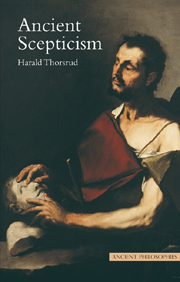Book contents
- Frontmatter
- Contents
- Preface
- Sources and abbreviations
- Chronology
- 1 Introduction
- 2 Pyrrho and Timon: the origin of Pyrrhonian Scepticism
- 3 Arcesilaus: the origin of Academic Scepticism
- 4 Carneades
- 5 Cicero: the end of the sceptical Academy
- 6 Aenesidemus: the Pyrrhonian revival
- 7 Sextus Empiricus: the consistency of Pyrrhonian Scepticism
- 8 Pyrrhonian arguments
- 9 The (ordinary) life of a Pyrrhonist
- Notes
- Guide to further reading
- References
- Index of passages
- Index
7 - Sextus Empiricus: the consistency of Pyrrhonian Scepticism
- Frontmatter
- Contents
- Preface
- Sources and abbreviations
- Chronology
- 1 Introduction
- 2 Pyrrho and Timon: the origin of Pyrrhonian Scepticism
- 3 Arcesilaus: the origin of Academic Scepticism
- 4 Carneades
- 5 Cicero: the end of the sceptical Academy
- 6 Aenesidemus: the Pyrrhonian revival
- 7 Sextus Empiricus: the consistency of Pyrrhonian Scepticism
- 8 Pyrrhonian arguments
- 9 The (ordinary) life of a Pyrrhonist
- Notes
- Guide to further reading
- References
- Index of passages
- Index
Summary
Whatever became of Pyrrhonian Scepticism in the wake of Aenesidemus, it did not make much of an impression on Seneca, who remarks in the early 60s ce that there is no one to hand on the teachings of Pyrrho (Natural Questions 7.32). On the other hand, looking back from the third century ce, Diogenes draws a lineage of Pyrrhonian teachers and students from Pyrrho all the way up to Sextus Empiricus and his student Saturninus (DL 9.115–16). The list probably exhibits Diogenes' passion for genealogy more than historical truth. But it is likely that there was some continuity of sceptical practice from the time of Aenesidemus since, more than 200 years later, Sextus draws on a rich tradition of sceptical argument that clearly was not the work of just one Sceptic.
Indeed, Sextus himself sometimes seems not to be just one Sceptic either. There are a number of strands in his works, not all of which fit comfortably together. The most likely explanation is that there were earlier, incompatible versions of Pyrrhonism recorded in his sources, and that Sextus drew from them with little concern for consistency. Whether he should have been concerned with consistency is a topic to be explored later. Despite these apparently inconsistent sceptical strands in Sextus' texts, we can discern a distinctive voice at work, and we can extract a coherent philosophical position, or rather practice.
- Type
- Chapter
- Information
- Ancient Scepticism , pp. 123 - 146Publisher: Acumen PublishingPrint publication year: 2008

